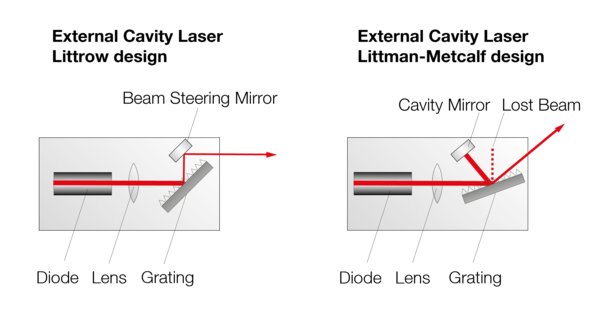Actuators for Laser Phase and Frequency Control
The last element of every feedback loop for phase and frequency locking is the actuator. It performs phase and frequency adjustments based on the control signal. While external components like electro-optic modulators (EOMs) or acousto-optic modulators (AOMs) can be used to change the frequency or phase, in this application note we focus on laser parameters that can be adjusted and lead to frequency changes.
A laser type which is predestined for fast and broadband tuning is the external cavity diode laser (ECDL). Here we will discuss four ways to adjust the frequency of an ECDL: changing the temperature of the diode, changing the piezo voltage which controls position and angle of the grating, adjusting the current which drives the laser diode, and changing the voltage of an intra-cavity EOM.

Changing the temperature of the diode will change the laser frequency by a large amount, typical tuning coefficients are changes of 0.1 nm/K. However, as it typically takes quite a while for the diode to thermalize (several seconds for a change of 1 K) this is a very slow way to adjust the frequency and therefore this option is rarely used for this purpose. However, for another type of diode lasers based on DFB diodes (Distributed FeedBack diodes) without an external grating, changing the temperature is indeed used to adjust the laser frequency.
In TOPTICA´s ECDLs the grating used for frequency selection is mounted on a piezo. Changing the piezo voltage changes the position and the angle of the grating and thus leads to a frequency change. It offers the possibility to adjust the frequency over a large range. Typical tuning coefficients are on the order of 1 GHz/V. Locking the laser frequency via the piezo voltage offers a bandwidth of several kHz and is therefore typically used to counteract rather slow frequency drifts.
Modulating the current driving the laser diode changes the refractive index of the semiconductor and thus also leads to frequency changes. Typical tuning coefficients are approximately 0.1 GHz/mA. Modulating the current already allows to modulate the laser frequency with a bandwidth of several MHz. It is therefore the typical actuator used for reducing the laser linewidth. Typically a current lock is combined with a slow piezo lock counteracting large drifts because changing the laser current also causes changes of the laser power. Therefore, only fast and small frequency fluctuations in the kHz range should be compensated by changing the laser current.
A method which is not so common yet, is an intra-cavity EOM which also allows to quickly change the refractive index. It allows for even faster frequency adjustments while the range over which the frequency can be tuned is typically very small.
